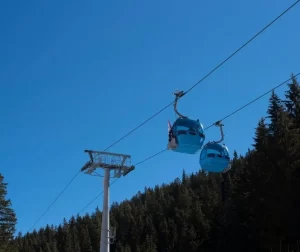Rila Monastery is 95 km away from Bansko.
The Rila holy monastery was created in the first half of the 10th century. Its history is related to the first Bulgarian hermit st. John Rilski, who settled in the monastery area and gave himself fasting and prayer. In the beginning, the place of the monastery was close to the cave that the saint chose to inhabit. After his death in 946, St. John Rilski was buried near his abode. Tsar Peter (927–969) carried the relics of the Rila Miracle Worker to the former city of Sedets (now the capital Sofia) and then, according to historians’ assumptions, he was canonized as a saint. The relics of St. John Rilski were returned to the Rila Monastery in 1469.
In 1961 the Rila Monastery was declared the National Museum “Rila Monastery”, in 1976 – a National Historical Reserve, and in 1983 UNESCO included the monastery in the list of world cultural heritage. In 1991 the state restored the monastic status of the monastery and closed the institution National Museum “Rila Monastery”. The Rila Monastery, the Hrelyov’s Tower, the church, and the monastery buildings were declared a group architectural, artistic, and historical complex of national importance in 1992.
In its current form, the Rila Holy Monastery is from the 19th century, with only the new part of the eastern monastery wing being from the 20th century. The oldest building in the holy monastery is the Hrelyov’s Tower, built in the XIV century (1335) It was the fortress of the monastery, as well as a dwelling for the monks in troubled times. On the top fifth floor of the 24-meter high tower is the chapel “Transfiguration of the Lord”. Currently, the Ridge Tower is open for visits during the summer season, as part of the 14th-century frescoes can be seen through the window niches of the chapel.
The entire area of the holy abode, including the church, residential and business buildings, is 8800 sq.m. Stone, 22 meters high walls surround the spacious monastery yard, the Nativity of the Virgin Mary Temple, the Hrleov’s Tower, the museum, the residential and business buildings. The monastery has about 300 premises, 100 of which are monastic cells.
On the site of an old temple in 1834 – 1837 was built the main monastery church “Nativity of the Virgin Mary”. It is five-coupol, cruciate, with two side chapels and three altar niches. Impressive are the carved iconostasis and frescoes, made by Samokov and swimwear masters. Many artists of the brush and chit worked in the temple, but only Zachary Zograf left his autograph. In the church is located the coffin with relics of the founder of the monastery st. John Rilski, the miraculous icon “St. Constantine and Helena” 11th century Virgin Mary, the miraculous icon of St. John Rilski from the XVIII century, many iconostases and kissing icons from the XIX century.
Since the end of the 19th century, there has been a museum in the Rila Holy Monastery, which exhibits relics related to the history of the monastery over the centuries. The museum exposition includes valuable examples of Bulgarian and foreign art during the period 14th -19th centuries. The most valuable exhibit is the wooden cross with an exquisite miniature carving made by Father Raphael. For many years he worked on it the master carving, used the finest chisels and tools, and completed it in 1802 when he went blind from the hard work on this masterpiece. It depicts 36 biblical scenes – 18 on each side of the cross, and over 600 miniature figures.
The exposition of the monastery farm next to the Samokov Gate includes the mill, the old monastery oven, objects related to the business activity of the monastery – forestry, cattle breeding, agriculture, etc. On the ground floor of the northern monastery, the wing is located the magernitsa (the old monastery kitchen). It is a 22-meter chimney with a conical shape, in it are the large casas, in which in the past monks-magers prepared a curban (soup) for the guests of the monastery during large holidays.
In the Ethnographic Museum and in the Renaissance drawing rooms in the northern wing of the monastery you can see fabrics, national costumes from different ethnographic areas, different vessels – gifts from different settlements and from pilgrims of the monastery. Those wishing to visit them will pay an entrance fee to the Church-History Museum.
Rila Monastery is an active male monastery. Car and bus parking lots are separated in front of the two monastery gates. The monastery offers an overnight stay, and in the monastery bookstore and in the shops of the Hrleov’s Tower, as well as in the area around the monastery, icons, albums, cards, souvenirs, as well as articles from traditional Bulgarian crafts can be bought.
Those who travel to the monastery on the newly opened highway “Struma” should keep track of the indicator signs for the town of Struma. Kocherinovo, since the same exit of the highway is also used for the Rila Holy Monastery.





